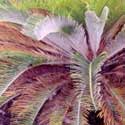White Malady Strikes! The Cycad Aulacaspis Scale (CAS) Takes Its Toll
 In many areas of Naples the king and queen sago (cycad) population
is under attack by Aulacaspis yasumatsui a small white scale from
Asia. This little white scale that arrived in the Naples area about
1997 settles on the undersides of the fronds changing them to a glowing
white, resembling a flocked Christmas tree. This flocked appearance
is sort of attractive, but the sagos react adversely to the little
scales piercing-feeding activity by turning brown and dying.
In many areas of Naples the king and queen sago (cycad) population
is under attack by Aulacaspis yasumatsui a small white scale from
Asia. This little white scale that arrived in the Naples area about
1997 settles on the undersides of the fronds changing them to a glowing
white, resembling a flocked Christmas tree. This flocked appearance
is sort of attractive, but the sagos react adversely to the little
scales piercing-feeding activity by turning brown and dying.
Cycad aulacaspis scale insects have encrusted this sago like barnacles on a ship. Without intervention, this sucking insect will eliminate these classic plants from the Florida landscape. (Photograph by Doug Caldwell, University of Florida).
 Scales feed under the frond stubs on the trunk
(right), under the woolly material, making them impossible to reach
with a spray. (Photograph by Doug Caldwell, University of Florida).
Scales feed under the frond stubs on the trunk
(right), under the woolly material, making them impossible to reach
with a spray. (Photograph by Doug Caldwell, University of Florida).
This pest is very difficult to manage, forget the word control at this point in time. This scale is from Thailand where it is not considered that big of a deal because the native insect parasites and predators keep it at bay. Without the normal compliment of insect enemies in Florida, scale populations take off unchecked. Not only that, but it feeds on underground structures, especially at the point where new "pups" originate, and is untouchable with most homeowner-use type of insecticides. Populations also accumulate on the underside of the plant's thick frond stubs on the trunk. This pest has repeating, overlapping generations probably at a monthly clip in south Florida. This means a constant re-invasion every 4 to 6 weeks.
A tiny wasp parasite and a predator beetle from the scale's homeland that were released 3 or so years ago seem to be establishing! Unfortunately, I don't think that these good bugs are aggressive enough to help many of our already infested cycads.
What To Do: Scale insects are difficult to control. A systemic insecticide is needed for the stages that feed hidden away, at the base of the emerging "pups" and under the thick woody plates (petiole base) on the trunk. My test with 2% horticultural mineral oil; 2% Safer Insecticidal Soap and 1.56% Organocide solutions, resulted in only 47%, 5% and 21% mortality, respectively, of the second instar stage. Not good enough! The best strategy, would be a systemic compound which would be absorbed into the root system as a soil treatment application and then move upwards into the foliage to get the scales on the fronds and on the trunk as well as the scale insects feeding underground. Unfortunately, most systemic insecticides (Merit, Orthene and DiSyston) applied as a soil application (injection, granular or drench) have given mixed results. Pesticide trials are being conducted at several University of Florida locations.
If the scale population has exploded and the predators and parasites are not protecting the cycad sufficiently, try using a product with Orthene (acephate). Also use Disyston granular as a systemic root treatment. This recommendation will be updated following some forthcoming test results.
Plant Selection: A scale resistant, substitute plant with a form similar to the king sago, is Dioon edule or perhaps some agave species or Phoenix roebelinii, may work.
Additional Information:
For more information on home gardening, contact the Collier County Extension Service (353-4244). Extension programs are open to all persons without regard to race, color, creed, sex, handicap or national origin. Visit our web site for more information.
Here is a Adobe Acrobat PDF of this document. (180KB pdf)


